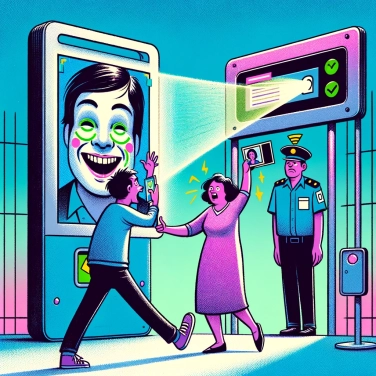Facial recognition technology can sometimes be tricked by photos because the algorithms used rely on characteristics and visual data that can be reproduced or modified to deceive the system.

Facial recognition systems often use methods known as "liveness detection", which are supposed to distinguish real faces from mere photos. However, these methods typically rely on simple cues, such as analyzing light reflections in the eyes, detecting micro-movements of the face (blinking, slight head movements), or even measuring the heat emitted by the skin. The problem is that these factors can easily be tricked or imitated by a high-resolution photo displayed on a screen, or even a short video playing on loop. Moreover, many of these methods are not yet sensitive or sophisticated enough to differentiate between a real face and a high-quality static representation. These technical flaws explain why a simple selfie can sometimes be enough to fool a system deemed "secure".
Facial recognition systems struggle significantly when the lighting changes or when the head is not directly in front of the camera. Low light or a strong shadow on the face makes it very difficult to identify the usual distinctive features. The same goes for unusual angles: a capture taken from the side or from below alters the proportions and shape of facial features. As a result, whenever the head position or lighting deviates too much from the reference photo in the system, recognition can easily make mistakes and confuse a real person with a simple image.
Facial recognition algorithms often rely on the analysis of key points on the face, such as the location of the eyes, the distance between them, or even the overall shape of the face. The problem is that a photo presents these key points clearly and stably, making it easier for these systems to function. As a result, a simple photograph can be sufficient to create confusion, as these algorithms do not always have the ability to verify whether the face is 2D or 3D, or if it truly belongs to a person physically present. Without the ability to detect movement, blinking, or changing expressions, these systems sometimes consider a still image to be a real face. It is this weakness that allows a printed photo or one displayed on a screen to easily deceive facial recognition.
When a photo is modified intentionally or not, facial recognition systems can become completely lost. For example, an image with an intense beauty filter or Photoshop touch-ups can lead to an identification error, as the algorithm compares your real face to an artificially perfect or altered image. The same goes for when specific features are emphasized or diminished: refined nose, hollow cheeks, enlarged eyes... These modifications confuse the model, which relies on precise facial landmarks (distances between the eyes, width of the nose, shape of the chin). Another tricky point is frozen or unusual expressions in certain photos, like a forced smile or grimace, which can also skew automatic comparisons.
Some users manage to trick facial recognition systems with simple methods. One of the most common involves presenting a printed photo or displayed on a screen in front of the camera: sometimes it works if the system does not properly check for texture, depth, or the natural movements characteristic of a real face. Others use techniques called deepfakes to generate a very realistic video or image of another person. Some even go so far as to wear realistic masks or attach specific accessories to their face to confuse the algorithms that detect typical human facial features. Special glasses, with targeted designs or patterns, for example, easily disrupt algorithms by altering the way they detect essential features. These approaches deceive the systems simply because they exploit the current limitations of live verification techniques or algorithms that look for precise landmarks in the image.
Did you know that special glasses or strategic makeup called 'adversarial makeup' can deceive certain facial recognition algorithms by disrupting the key points used by these systems?
Did you know that facial recognition often relies on the analysis of "facial reference points" (eyes, nose, mouth), and that any alteration or obscuring of these key elements makes recognition particularly prone to errors?
Did you know that a study conducted by researchers found that facial recognition systems can sometimes exhibit biases related to age, gender, or ethnicity, resulting in a higher error rate for certain categories of users?
Did you know that there are algorithms specifically trained to identify presentation attacks (photo or video attacks), but they can still be vulnerable to very high-resolution photos or carefully crafted videos?
Sure! Here’s the translation: "Yes, to a certain extent. If misused or hacked, this technology could expose sensitive information to third parties. Therefore, it is important to carefully choose the contexts in which we allow its use and to always prioritize systems with strong security and privacy policies."
Yes, often, presenting a simple printed photograph or one on a screen is enough to deceive certain systems based on algorithms that do not properly verify the anatomical authenticity or signs of life of the presented face.
An advanced system uses techniques such as blink detection, in-depth analysis through infrared cameras (3D vision), analysis of micro-facial movements, and recognition of potential reflections characteristic of an image printed or displayed on a screen.
No, facial recognition can encounter significant difficulties in low or overly bright lighting conditions when contrasts or colors are not clearly discernible. Uniform and sufficient lighting greatly enhances its effectiveness.
Sure, here is the translation: "Yes, certain accessories can conceal or alter specific identification points, thereby disrupting facial recognition. However, recent algorithms that use multiple facial reference points are more resistant to these strategies."
No, facial recognition is not infallible. Factors such as image quality, lighting, angle of capture, or the presence of a photo or video can deceive the algorithms.

No one has answered this quiz yet, be the first!' :-)
Question 1/5